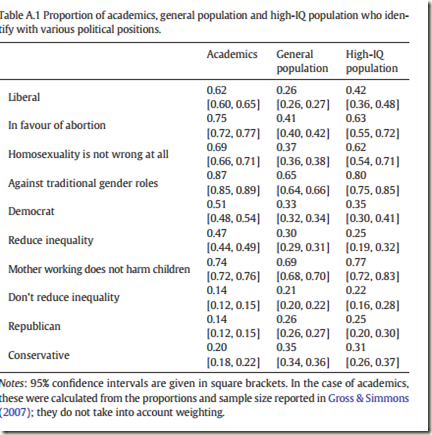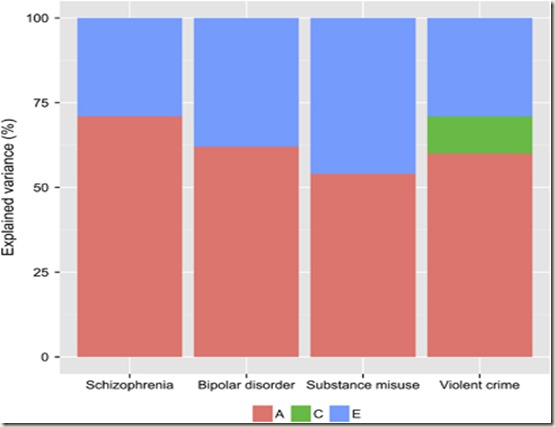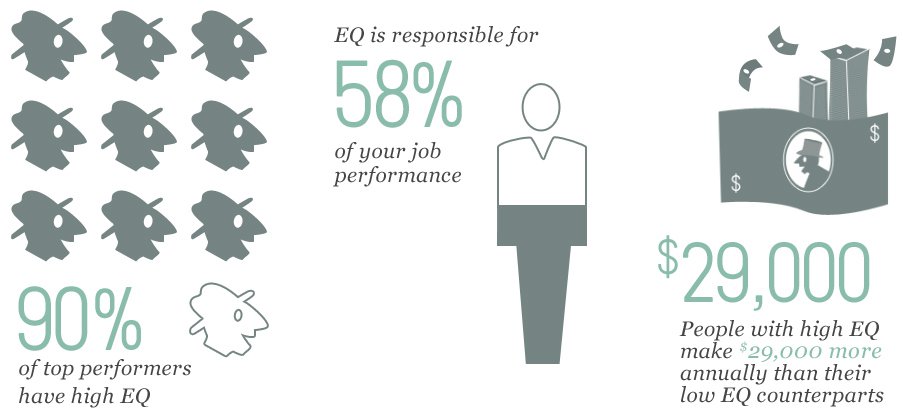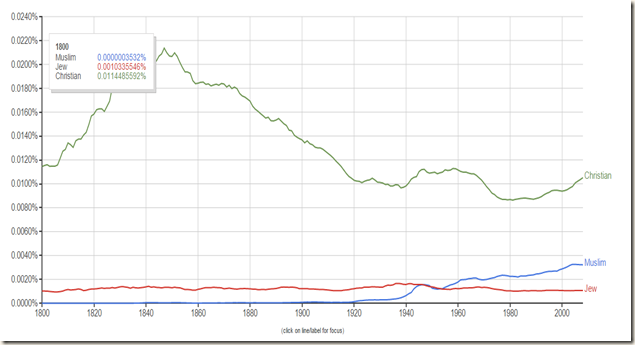There is a long academic tradition of regarding opponents as mentally disturbed. Such condemnatory revelation is done more in sorrow than malevolence, the investigators would have us believe. Academia has looked long and hard at Right wingers and pronounced them a pretty odd bunch, suffering from something called The Authoritarian Personality. Fascists is the more usual appellation, and their horrible opinions are calibrated on the F scale. What do Right wing academics say about Lefties? Not much, because there are few Right wing academics in social psychology.
One interpretation popular among Lefties is that the brighter you are, the more likely you are to be a Leftie. At the higher levels of intellect you see things as they really are: Socialist. There is a fair bit of data to support this position. The alternative explanation is that the brightest people want to run things and make money, and regard academia as a boring waste of time. Bright people look at the bitter way academics argue, all the more petulantly and virulently in obscure matters because “the stakes are so low” and escape into the real world. Very bright people tend to the Right, and in their pursuit of power and wealth simply don’t care what academics chatter about, because their mutterings don’t make any difference. The Brightest have left college to compete for the glittering prizes, and the lefties are the social incompetents who remain perpetual students, striking absurd postures about world events over which they have no influence.
At this point you might like to look at a previous post which sets out the general thesis that the Left gather together the very brightest people and the dullest, thus joining together in a U shaped curve the clever idealists who really believe in Leftism and the dull ones who only sign up because they are the beneficiaries. This last group are not bright, but know what is good for them.
http://drjamesthompson.blogspot.co.uk/2014/10/are-lefties-clever-or-just-grasping.html
Then go through the comments, and note that on 3rd October 2014 Noah Carl writes in to say: My reading of the literature is somewhat different to Solon's. I am currently working on a critical comment piece, which I intend to submit as a response.
Here, after the usual paper-journal delay, is Noah Carl’s interesting paper: Can intelligence explain the overrepresentation of liberals and leftists in American academia? Intelligence Volume 53, November–December 2015, Pages 181–193 doi:10.1016/j.intell.2015.10.008
https://drive.google.com/file/d/0B3c4TxciNeJZVl9kOE5jMU90a1U/view?usp=sharing
The author says: It is well known that individuals with so-called liberal or leftist views are overrepresented in American academia. By bringing together data on American academics, the general population and a high-IQ population, the present study investigates how much of this overrepresentation can be explained by intelligence. It finds that intelligence can account for most of the disparity between academics and the general population on the issues of abortion, homosexuality and traditional gender roles. By contrast, it finds that intelligence cannot account for any of the disparity between academics and the general population on the issue of income inequality. But for methodological reasons, this finding is tentative. Furthermore, the paper finds that intelligence may account for less than half of the disparity on liberal versus conservative ideology, and much less than half the disparity on Democrat versus Republican identity. Following the analysis, eight alternative explanations for liberal and leftist overrepresentation are reviewed.
Overrepresentation of liberals and Democrats appears to be largest in the humanities, the social sciences, and the arts (particularly sociology, anthropology and the performing arts), and appears to be smallest in economics, business, computer science, engineering and military science. For example, the ratio of liberal to conservative English literature professors may be as high as 28:1, while the ratio of Democrat to Republican sociology professors may be as high as 44:1 . Overrepresentation in the physical sciences, the biological sciences and mathematics appears to be intermediate, though still considerable.
After reviewing the political affiliations of American law professors, Lindgren (2015) concluded that, “By some measures, in 1997 the most underrepresented racially defined groups were Non-Hispanic white Republicans and non-Hispanic white Protestants”. ” Similarly, when the psychologist Jonathan Haidt asked attendees at the 2011 meeting of the Society for Personality and Social Psychology to indicate their political affiliations via a show of hands, he counted only 3 conservatives and only 12 libertarians, but approximately 800 liberals (Duarte et al., 2014). The 23rd annual Commencement Speakers Survey carried out by Young America's Foundation documented a ratio of six liberal speakers for every one conservative speaker among the top 100 universities. And notably in 2014, invitations to at least six prominent commencement speakers' were met with protests on campus from liberal or leftist student groups, leading to the cancellation of four.(Strauss, 2014; Chotiner, 2014). It is important to keep in mind that American academia has probably not always been so skewed toward liberalism and leftism. Duarte et al., (2014) compiled historical figures on academic psychologists' partisan affiliations, which indicate that the ratio of Democrats to Republicans may have been as low as 2:1 or even parity in the 1920s.
High intelligence may explain Leftism for the following reasons: Academic advancement requires very high intelligence, and since few individuals with conservative or rightist views possess very high intelligence, such individuals are comparatively scarce within the academy. At present, there is a certain amount of circumstantial evidence for this hypothesis. Numerous studies have found that individuals with higher intelligence to be more socially liberal on issues such as gay marriage, abortion, working women, free speech and marijuana legalisation.
Americans with higher intelligence are apparently more likely to identify as liberal on a liberal/conservatism scale. And compared to Americans with only high intelligence, those with the highest intelligence are more likely to identify as Democrat, more likely to support welfare for the poor, and more likely to favour affirmative action for minorities. In addition, scholarly elites such as Nobel laureates, Pulitzer Prize winners and Putnam fellows have donated to the Democratic Party far more often than they have donated to the Republican Party. However, there is also some circumstantial evidence against the hypothesis. In particular, several studies have found that individuals with higher intelligence tend to be more economically rightist in areas such as redistribution of income and government control of the economy.
Method: Fig. 1 illustrates the method used for assessing how much of the overrepresentation of liberals and leftists in American academia can be explained by intelligence. I first bring together data on the political beliefs of three separate populations: academics, the general population, and a high-IQ population. I then calculate the proportion of each population that identifies with various political positions (e.g., thinking of oneself as a liberal, supporting the Democratic Party). The extent of overrepresentation for any particular position is simply the percentage point difference between academics and the general population (i.e., the total length of the right-hand bar in Fig. 1). And the fraction of this overrepresentation that can be explained by intelligence is simply the percentage-point difference between the high-IQ population and the general population divided by the percentage-point difference between academics and the general population (i.e., the grey portion of the right-hand bar divided by the total length of the bar). In the hypothetical case of Fig. 1, there is a 10 percentage-point gap between academics and the general population of which 50% (i.e., 5 percentage points) can be explained by intelligence.

This is a crude variance estimate method, but at least is clear in how it is being calculated, and seems reasonable.
I define the high-IQ population as the roughly 4% of GSS respondents who scored 10 out of 10 in the vocabulary test. Note that a score of 10 equates to a mean IQ of ~128, which is just under two standard deviations above the population mean. This is in line with estimates for the average IQ of academics that have been reported in the literature, though it may understate the intelligence of academics in the physical sciences, whilst possibly overstating the intelligence of academics in the social sciences and humanities (see Dutton & Lynn, 2014). Gibson and Light (1967) tested 148 male academics at Cambridge University, and reported a mean IQ of ~128 among physicists, and of ~122 among social scientists.
So, given that method, here are some of the political views showing what proportion of those viewpoints might be accounted for by intelligence.

Here, in tabular form, are the striking differences between academics, the general public, and high IQ people.

I have summarised Noah’s possible explanations very briefly, but the paper is particularly interesting on the more detailed arguments:
1 Self selection: Academics may be more Open to Experience in personality.
2 Self selection: Academics less interested in making money and raising children.
3 Self selection: scholars can cope with ambiguity, conservatives not.
4 After self selection, social pressure strengthens group think.
5 Self selection: Academics have weedy, feeble physiques, were probably fearful and bullied, hence want restorative “justice”.
6 Academics become more liberal through groupthink.
7 Academics have low pay relative to their educational level compared with independent professionals, resent them, want equality of influence.
8 Academics discriminate against any candidate with right wing inclinations.
Personally, I see all these as boiling down to two factors: self selection and social pressure.
Noah concludes: Intelligence can account for most of the disparity between academics and the general population on the issues of abortion, homosexuality and traditional gender roles. By contrast, intelligence cannot account for any of the disparity between academics and the general population on the issue of income inequality. Furthermore, intelligence may account for less than half of the disparity on liberal versus conservative ideology, and much less than half the disparity on Democrat versus Republican identity. Possible explanations for the remaining overrepresentation comprise: self-selection on personality, interests, cognitive style or preferences; social homophily and political typing; self-selection on strength and stature; individual conformity; status inconsistency; and discrimination.
In sum, this paper shows that intelligence is a large part of the answer, but not all of it. The paper also shows the very clear difference in political and social attitudes between academia and society as a whole. It does a great service in showing this yawning chasm of attitudes.
If you evaluate arguments by questioning the motives of the proponents (does the Left do this more frequently than the Right?) then academia is so biased that its findings should be set aside. Nothing these apparatchiks “find” can be trusted. They are Lefties, espousing Leftie causes, and they are a burden on the public purse. On the other hand, if all these disciplines have strong methods and a respect for facts, then the standard procedures of empirical science should prove sufficient to reveal errors in research, so science should self correct. On this, possibly too optimistic reading, there is no need to pack academia with Right wing scholars (and such affirmative action should be anathema to them anyway) because the truth will out in the end. In conclusion, we have to examine arguments regardless of motives, and seek to improve the accuracy and soundness of research. A topic for a blog, I think.



























